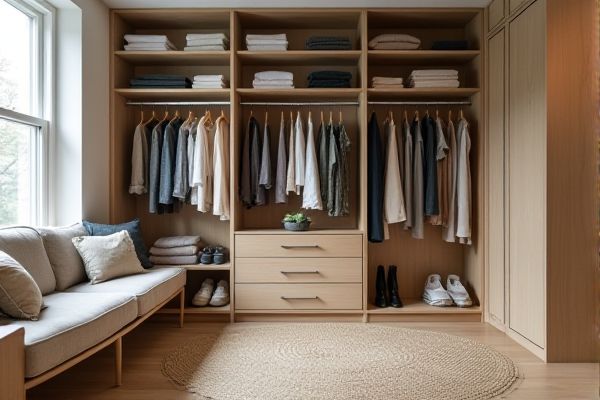
Closet organizers maximize your existing space by adding compartments and shelves, while wardrobes provide standalone storage solutions that are often customizable and portable. Discover which option best suits your needs and how to optimize your storage by reading the rest of the article.
Table of Comparison
| Feature | Closet Organizer | Wardrobe |
|---|---|---|
| Definition | Storage system installed inside or outside a closet to organize clothes and accessories. | Freestanding cabinet used for storing clothes, often portable and independent of room structures. |
| Installation | Built-in or mounted, requires some assembly or permanent fitting. | No installation needed; standalone furniture. |
| Space Optimization | Maximizes existing closet space, customizable shelves and compartments. | Limited to wardrobe dimensions, less customizable. |
| Mobility | Fixed, not portable once installed. | Portable; easy to relocate. |
| Cost | Typically more affordable, but depends on customization. | Higher upfront cost due to furniture quality. |
| Capacity | Optimized for small to medium storage needs inside closets. | Larger storage capacity, suitable for rooms without built-in closets. |
| Design | Minimalistic and functional, blends with closet interiors. | Varied styles from traditional to modern, visible as room furniture. |
| Maintenance | Low maintenance, integrated into the closet environment. | Requires cleaning and upkeep like any furniture piece. |
Closet Organizer vs Wardrobe: Key Differences
Closet organizers maximize your existing space with customizable shelves, drawers, and hanging solutions designed to fit inside closets of varying sizes. Wardrobes are standalone furniture pieces offering enclosed storage, typically with doors, designed for clothes and accessories in rooms lacking built-in closets. Choosing between a closet organizer and a wardrobe depends on your space constraints, organizational needs, and whether built-in storage already exists.
Space Efficiency: Which Maximizes Storage?
Closet organizers maximize storage space by customizing shelves, drawers, and hanging areas to fit specific items, utilizing vertical space efficiently and reducing clutter. Wardrobes, while providing a designated, enclosed storage area, often offer fixed compartments that may limit flexibility and underutilize available room. Choosing a closet organizer generally results in better space efficiency due to its adaptable design tailored to individual storage needs.
Design and Customization Options
Closet organizers offer extensive design and customization options tailored to maximize your storage efficiency, featuring adjustable shelves, hanging rods, and modular compartments. Wardrobes typically come with fixed interiors and less flexibility, often limited to predetermined shelving and hanging space configurations. Choosing a closet organizer allows for a personalized solution that adapts to your specific clothing and accessory needs.
Installation and Maintenance
Closet organizers typically offer easier installation, often requiring minimal tools and customizable modular components that adapt to existing spaces. Wardrobes, especially freestanding or built-in models, may demand professional installation due to their weight and structural complexity. Maintenance for closet organizers involves occasional dusting and rearranging, while wardrobes require more comprehensive upkeep, including surface polishing and hardware checks to ensure durability.
Cost Comparison: Closet Organizer vs Wardrobe
Closet organizers generally offer a more affordable solution compared to wardrobes, with prices ranging from $100 to $500 depending on materials and customization options. Wardrobes, often made of solid wood or high-end finishes, typically cost between $500 and $3,000, reflecting their durability and style. Choosing a closet organizer can maximize storage efficiency at a lower price point, while wardrobes provide a more permanent and aesthetic storage solution with higher investment.
Durability and Material Choices
Closet organizers typically feature lightweight materials such as wire, plastic, or engineered wood, offering moderate durability suited for temporary or flexible storage needs. In contrast, wardrobes are constructed from solid wood, metal, or high-quality MDF, ensuring enhanced durability and longevity for heavy use. Material choices in wardrobes support robust weight capacity and aesthetic appeal, while closet organizers prioritize versatility and ease of installation.
Suitability for Different Room Sizes
Closet organizers are ideal for small to medium-sized rooms, offering customizable storage solutions that maximize limited space through modular shelves, drawers, and hanging rods. Wardrobes suit larger rooms better by providing ample enclosed storage, often featuring full-length doors and more substantial capacity for clothing and accessories. Small rooms benefit from closet organizers' flexibility, while spacious rooms can accommodate wardrobes' bulkier design and increased storage volume.
Accessibility and Ease of Use
Closet organizers provide improved accessibility by maximizing space with customizable shelves, drawers, and hanging areas tailored to your specific needs. Wardrobes often have fixed compartments that can limit ease of use, making it harder to quickly locate items. You benefit from a closet organizer's flexibility, which streamlines daily routines and enhances overall convenience in managing your clothing and accessories.
Aesthetics and Home Decor Impact
Closet organizers offer a sleek, customizable solution that enhances room aesthetics by reducing clutter and creating a streamlined appearance, complementing modern interior design trends. Wardrobes, often designed as standalone furniture pieces, serve as both functional storage and focal points, adding character and style through varied materials and finishes. Choosing between the two depends on desired visual impact and spatial integration within home decor.
Pros and Cons: Closet Organizer vs Wardrobe
Closet organizers maximize your existing space with customizable shelves, drawers, and hanging options, offering flexibility and better organization without requiring extra room. Wardrobes provide standalone storage that is portable and often feature locking doors for security but can take up significant floor space and may offer less customization. Choosing between a closet organizer and a wardrobe depends on your space constraints, organizational needs, and whether you prefer built-in or freestanding storage solutions.
 homyna.com
homyna.com